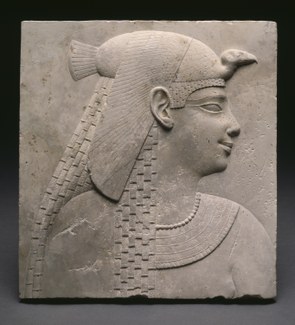The function of this plaque is uncertain: like all other sculptor’s models in this exhibition, it has been interpreted as a votive object for sanctuaries, or as practice piece for apprentices.
The subject matter appears straightforward but is in fact ambiguous: the woman wears a braided tripartite wig decorated with a vulture cap, an element used in the representation of divinities and queens since the Old Kingdom (ca. 2500 BCE). In the Ptolemaic period the vulture is the hieroglyph sign for “mother,” with particular reference to Isis, mother of Horus. Considering the deliberate association between Isis, Osiris, Horus, and the ruling family (see the religious section of this exhibition), is the viewer looking at queen or a goddess?
The ambiguity that characterizes the plaque suggests that the difficulty in understanding its iconographic motifs is not the result of our imperfect knowledge but perhaps the conscious choice by the artists and their patrons. Thus, this image could have very well baffled the ancient viewer as much as continues to puzzle the modern one.
Emily Teeter. Egyptian Art. Art Institute of Chicago Museum Studies, 20, no.1, 1994. 28-29, no.13
